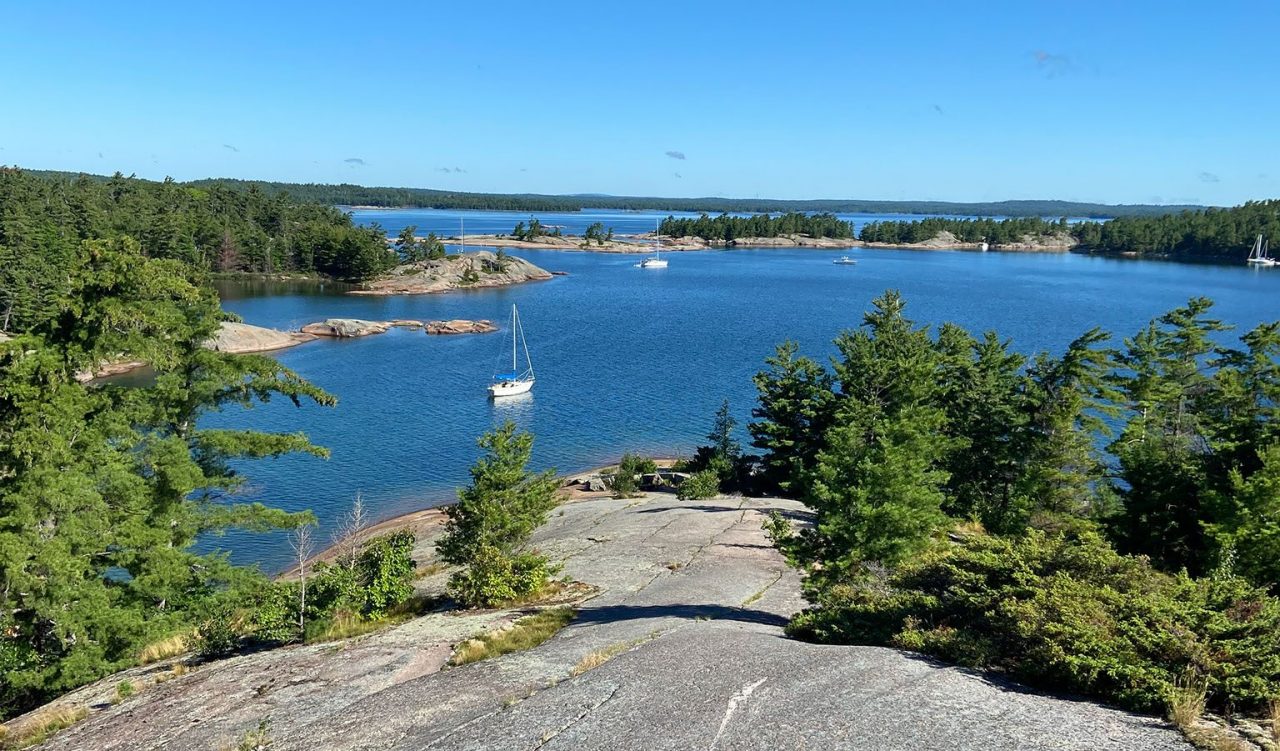A Sailing Odyssey, Part I

When I was a boy during summers in northern Michigan, there was one adventure that dwarfed all others: sailing to the North Channel. It was a distant, mythic place of pristine beauty and wrecked boats where intrepid sailors matched their skills with the forces of nature — where islands had rattlesnakes, fish were huge, and the water was clean enough to drink. It was a place where teenaged boys left as callow deckhands and returned as bearded young men, telling tales around the fire.
Some think the Les Cheneaux Islands where we go in the eastern Upper Peninsula are remote, but they’re suburbs compared to the North Channel, an arcing body of Canadian water 180 miles long and 20 miles wide that forms the northernmost part of Lake Huron. With countless uninhabited islands and infrequent harbor towns, it’s considered the best freshwater cruising in the world.
I’d always wanted to sail the North Channel, but I probably never would have had I not decided about five years ago to climb up onto an old boat that had belonged to my father. Though he’d lived in Cincinnati, Dad had a sideline business selling sailboats in Cleveland, and this particular boat — a 1984 Catalina 27 — had been dropped while being trucked to a customer, cracking its keel. After that, it couldn’t be sold, so we ended up with it. And for five years, Dad puttered around in it. I was in my mid 20s then and busy with work, so I only sailed on it twice with him. After Dad had a stroke in 1990, the Catalina was parked on a trailer in the woods, and there it remained, high, dry and forgotten for the next 27 years.
Why I hoisted myself up 10 feet onto that trailer five years ago, I can’t remember. Maybe it was an accident. Certainly I was curious. Upon reaching the leaf-covered cockpit, the first thing I noticed was that the blue plastic wrap was torn and the hatchway to the cabin below was open to the weather. Peering into the dark cabin, I could see about 18 inches of stagnant water. How long had the water been there? Was the boat ruined? I didn’t know. But I got a hand-pump and a bucket and an hour later, I’d pumped it dry. I called the marina and asked if they could put it in the water to see if the engine still worked.
“Don’t waste your money,” said Dale at the marina. “It’s been 30 years — that engine will never start.” I told him I was curious to test it anyway and he reiterated, “I’m telling you — it’s shot.” I asked him to just humor me and put it in the water. “My Dad liked that boat and I don’t want to get rid of it unless I’m sure it’s no good.” Two days later, Dale called and said, “I don’t believe it, but that little diesel engine started right up.”
After that, I set to work scrubbing the worst of the grime out of the interior, and then I put it away again, with new plastic wrap to keep it dry. That was in 2017, and I mentioned to my sons Sam and Henry, then 27 and 23, that maybe we should take a trip to the North Channel. In 2019, our schedules finally meshed, and the 10-day trip was a go. With a real voyage ahead, I had to get the boat ready. I removed the cushion slipcovers and laundered them twice. I opened all the hatches for air flow, and for two days scrubbed and disinfected every inch of the interior until my fingers burned with detergent. With the boat finally clean enough to inhabit, I inventoried what was there.
Going through that cabin was like entering a long-sealed vault — a time capsule full of my father’s things 26 years after he died. Dad was a sailor. Four years as an officer on a destroyer in the Pacific during World War II meant that, unlike me or most people, he was undaunted by anything Lake Huron could throw at him. He’d sailed it top to bottom, skippering 250-mile races and taking my older siblings on North Channel trips. I came along unexpectedly years later and missed out on those. But here was all of his stuff: old LaSalle Yacht Sales business cards, sailing gloves, binoculars, and a Mills Brothers tape in the cassette player. In one compartment, a plastic case contained his nautical charts with the courses and favorite haunts he’d found in 20 years of North Channel sailing — all in his handwriting when he was a young man. The destinations were familiar — places I’d heard of but never been: Pilot’s Cove, Blind River, Gore Bay, Manitoulin Island, Little Current, and Killarney. And there was gear of all sorts. On a regular sailboat, you needed lots of gear. For cruising you needed much more, and this boat was loaded.
As I inspected everything in that cabin, it was like sitting with him again after so many years. At times, it was intense, and more than once, a tear welled as something triggered a memory. More than anything, though, it was uplifting. It was as if he were saying, “I’ve been waiting for you” — and that he’d be with us. It was actually uncanny how many times on the trip I needed something only to find it at my fingertips moments later.
The details of preparing were staggering. Making sure every single thing worked and was ship-shape was one thing. Planning, buying and packing supplies was another. Determining the possible routes and destinations — depending on wind direction — kept me up late, night after night, reading other cruisers’ logs, examining charts, and picking the right GPS. Much of it was exciting and fun, but accompanying the planning were responsibilities and anxieties that could swamp any reasonably even-keeled person. I had to learn emergency radio protocol and have functioning fire extinguishers, flares, an air horn, a whistle, emergency flags, first-aid materials, a life-ring and, of course, life jackets. We needed rain gear, flashlights, bug spray and an extra anchor in case we dragged. I made new screens to keep the bugs out. And a 35-foot mast meant I read all about lightning strikes. Beyond that were the ins and outs of Canadian maritime etiquette and what we’d need to pass Canadian customs, including finding or fashioning ownership, registration and insurance documents on a boat that had none.
To my knowledge, the keel had never been tested by a long trip, so the dinghy I procured was necessary not just for going ashore. If the keel let go and the boat sank, the boys and I would at least survive with a dinghy and paddles. Beyond whether the boat would hold up after 30 years on land, how would I fare skippering a 200-mile trip in big and unfamiliar waters? To top it all off, I’d just been diagnosed with a dangerously large aortic aneurysm. I’d learn a year later that it had been significantly mis-measured, but at the time, I’d been told to avoid straining and heavy lifting. That didn’t exactly jibe with winching in the jib in a heavy breeze. Would the aneurysm let go? Could my sons handle the boat alone?
When we finally set sail, all those fears and anxieties began to melt away. The 27-foot sloop performed beautifully in a variety of circumstances that tested its strength and my mettle as a blue-water skipper. The farther we sailed, the more trepidation yielded to exhilaration and a sense of accomplishment that we’d broken free and were entering a new and unexplored realm. The boys gained tremendous experience and we overcame obstacles we’d never anticipated. It was a great adventure and one that left me eager to return. But with a closed Canadian border, returning wasn’t possible until last summer.
(Coming next Thursday in Part II; Peril on the seas…)










